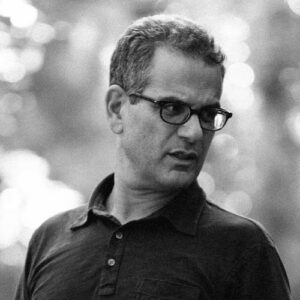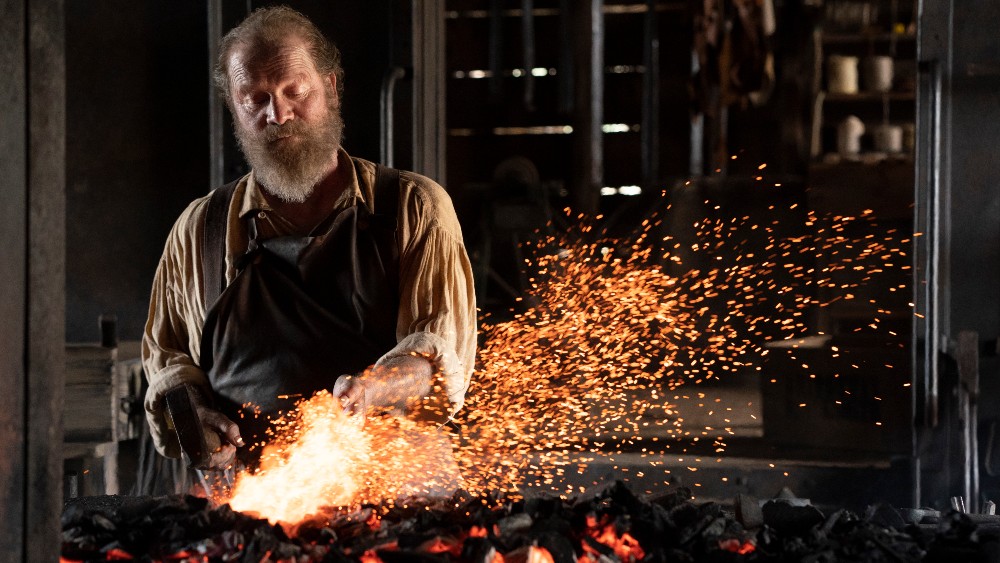
Adapted from Colson Whitehead‘s Pulitzer Prize-winning novel, The Underground Railroad has won critical acclaim for its view of slavery in the Deep South. Developed and directed by Barry Jenkins, the ten episodes are streaming on Amazon Prime Video.
Like Whitehead’s novel, the series layers myth and fantasy on top of historical events. The episodes follow Cora Randall (played by Thuso Mbedu) on her journey from a Georgia cotton plantation through the Carolinas, Tennessee, and Indiana. An escaped slave, she is pursued by the relentless Ridgeway (Joel Edgerton) and his young companion Homer (Chase Dillon).
Production Designer Mark Friedberg previously collaborated with Jenkins on his feature, If Beale Street Could Talk. In a career that includes a 2011 Emmy for Mildred Pierce, he has worked with Ang Lee, Todd Haynes, Jim Jarmusch, Wes Anderson, Ava DuVernay, and most recently Darren Aronofsky. Prior to The Underground Railroad he was the production designer on Todd Phillips‘ Joker.
Mr. Friedberg spoke with Below the Line via Zoom.

Below the Line: When did you start working on The Underground Railroad?
Mark Friedberg: Barry and I started talking about it, mostly in the abstract, while we were working on If Beale Street Could Talk. He already had writers working on it. I went on to Joker, and while I was doing that, we had serious talks. I did research, developed some concepts, and started in earnest in 2019. It’s one of the projects I’m proudest of in my entire career.
BTL: Did you find it difficult to work on a story with such violence and brutality?
Friedberg: I’m not designing brutality, I’m designing a world that existed on some levels in history. I think one answer to your question is that we weren’t focused solely on brutality and violence. We were focused on the response to it. We were focused on the endurance and the courage, on the determination of the people who not only survived slavery and all that came with it, but also thrived — or at least brought our country to a place of thriving. A lot of this story is about the contribution of people who managed to help build the country without compensation.
In building the slave quarters at the opening of the series, I wasn’t trying to make Auschwitz. It was the opposite — I was actually trying to communicate that these were human beings who had a community, even though they were treated worse than the cattle on the same plantation. To show that, we made the slave quarter its own place. We didn’t set it in the shadow of the big house as it was in the novel and as it was originally scripted. We set it in nature in a setting that’s almost beautiful.
BTL: Setting the slave quarters in a separate location came about in discussions with Mr. Jenkins?
Friedberg: The quarters open the story, so it’s how we come into the community. People living on their own, in their culture, in their own way. When the slave owners, the Randall brothers, came into that setting, they were interlopers, the people who shattered whatever good feeling there was there. So I pitched that as an idea, and Barry was right there with it. We had done a whole movie together, we had been working on this for a long time, we had a pretty open communication. But that was also because I understood his point of view. So it was really me taking his narrative point of view, his character point of view and applying it to my work.
I didn’t feel as a designer that slavery needed my extra help to communicate how horrible it was. We were interested in the contribution of the culture that we share of people who are treated the worst way. We also wanted to contrast this experience to the Valentine farm, a community without a man with a whip, without a murderous owner, but simply capitalist commerce that they were able to thrive under.
BTL: How elaborately did you build out the slave quarters?
Friedberg: If you’re a field slave, which most slaves were in the Deep South, it made more sense that you live near the fields, in this case, cotton fields. But we also wanted you to feel the cotton in our stories. Planting a cotton field, I mean, what a crazy thing to do. That’s what everybody said at first, but we tried it and it worked. We had a sugarcane field, and we had livestock, both in pens and running around. We had cane presses and smithies and cook houses and smoke houses. And we really tried to make whichever way you looked make sense, so that the actors who did their work in this place felt that they were in a place. It felt like that. I mean, I never worked so hard on a set. It was a strange thing to have this attachment to slave quarters, to what that group of buildings represented.
BTL: I’ve seen lots of Westerns with blacksmiths hammering horseshoes, but I’ve never seen anything like the forge you show later in the series. Was it operational?
Friedberg: Operational-ish. We had a few extras doing actual smithy work, but that giant forge was rigged. Actors had to work there.
There’s a through-line of blacksmithing in the series — that was important to Barry. There’s a metaphor in that fire about things being forged, being created, which was very much at the center of what the story’s about. Also a plantation blacksmith was a skilled and honored position, maybe a way up.
BTL: Can you talk about the mixture of real and fantasy, the magical realism in the series?
Friedberg: The title Underground Railroad refers in part to the network of human beings who risked their lives to free slaves during a time when that was illegal. The year the story takes place, the Fugitive Slave Act made it a federal offense to harbor a slave, and a federal offense not to aid in the recapture of a slave. That act inspired a lot of the tumult of its time. It enabled people like Ridgeway to go anywhere in the country, claim someone to be an escaped slave, and just extract them. Solomon Northup [12 Years a Slave] is a good example of that.
I think the title can be a metaphor for building the better parts of our society. The idea that there were forces countering the evil that was going on. In the novel and the series it’s a way to mix historical elements. In the first episode you’re on a slave plantation, in the next you’re in a city which has high-rise buildings, electric elevators, a place that’s clearly not 1850. From the content of the story it might be 1949, 1950, maybe Montgomery, Alabama. Or Tuskegee, where the government sanctioned medical experiments on human beings.
In his novel, Colson Whitehead put elements from different eras into the slavery period so we could look at them through the prism of our own time. Even in the short span since we finished making it, things have happened in our country, on television, in front of our eyes, including the rollback of voting rights. The idea that we’re past any of this, that we’re in a post-racial society, is what inspired this somewhat jumbled telling of history.
So I guess you can call it magical realism. It’s another way of looking at time. I think we’re so eager to absolve ourselves as we look back in history. This is a way to force us to peek into the mirror and see that some of these vestiges of slavery aren’t so vestigial. Maybe they’re institutional, structural. That’s one reason why the show goes from the slave experience to eugenics to the equivalent of Salem witch trials 200 years earlier. Think of it as a slightly less preachy way to think about the time we live in now. A way of looking at a non-linear history.
BTL: At the same time, the trains in The Underground Railroad are real, they’re not just metaphors.
Friedberg: The initial assumption on this movie was that they would be CGI. No one can make the kind of financial and engineering commitment to build a functional underground railroad. Plus there’s the fact that steam trains can’t run underground, they need oxygen.
But Barry didn’t want that. The first thing he said to me was, “I don’t know what else to say about the show, Mark, but real trains, real actors, all the time.” So real trains moving on real track.
I knew you can’t fit a train on a stage, that wasn’t going to work. Another thing that was clear is that we weren’t going to build the trains. And in America you can’t shoot on public tracks, not after that terrible accident in Georgia.
It became clear that we needed to find privately owned track with privately owned trains and build a tunnel on top of it. I also knew we needed basically four train stations, then the Chicago hub. When we started to figure out all the costs, we had to make one long piece, and build two of the smaller stations inside the larger ones and extract them. It wasn’t quite that simple, but that’s essentially how we were able to do it.
At the end of the day, Georgia made a lot of sense. I’ve always had a soft spot for the railroad museum in Savannah [Georgia State Railroad Museum], an amazing facility with a working wheelhouse and turntable. They became part of the crew. They ran the train safety, they helped us rig the trains to move. I think our train set ended up costing more than double the budget of Moonlight.
We used Savannah for the city of Griffin. I was very proud of it, it’s a very tricky episode. It’s got a feature amount of sets, but [cinematographer] James Laxton and I have a very close relationship. He’s an amazing partner to work with.
As hard as you’re working, it’s a lot easier with people you respect, you have a camaraderie with. And Barry’s one of the most special, dynamic, generous, inspiring people I’ve ever met. He touches you. There’s something about Barry that brings out the best of people. Not every director does that. And it’s not easy to do. I directed the second unit on this. So for a few days, every once in a while, I had to live the way he lived. I barely had to direct actors, and it was still intense, right? When the stakes are that high, it doesn’t always bring out the best version of you, you know? Not everyone reacts to pressure with complete grace and generosity. Most people don’t. Throughout this Mr. Jenkins was the most giving to the people who were having the hardest time. He’s taught me a lot, a lot more than just about film.
I’ve been designing sets for cinema for over 30 years. And every one of them feels like the first one, and every one of them is exciting, and every one of them is all you. But this one really got all of me. I mean, there weren’t too many molecules I went down there with that I came back with.
The Underground Railroad is now available to stream on Amazon Prime Video. All photos courtesy Amazon Studios.








